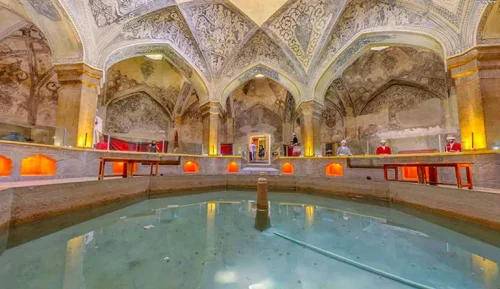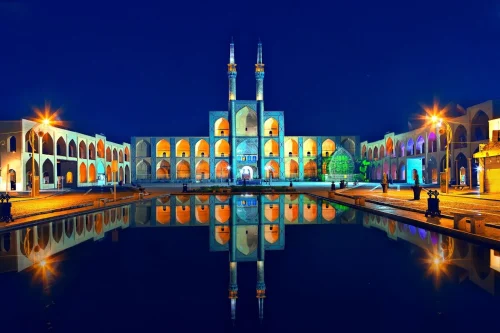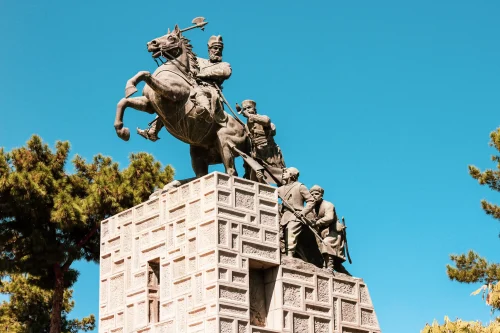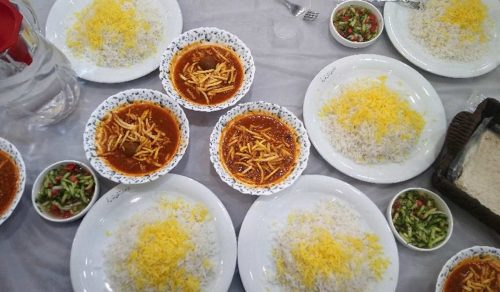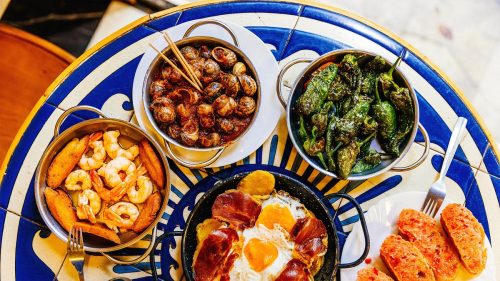Isfahan Handicrafts: 17 Most Popular Ones
Iran Charter is proud to introduce the Isfahan Handicrafts: 17 Most Popular Ones. These handicrafts not only represent the rich culture and art of Isfahan, but also reflect the unparalleled skills of the city’s artisans. From exquisite marquetry to unique and colorful enameling, each of these crafts is uniquely produced and decorated. By choosing handmade and authentic products from Iran Charter, you not only add a beautiful and valuable item to your home but also benefit from the support of a reputable brand. For further guidance, call 02191091190 or email info@irancharter.ir.
Khātamkari Isfahan: Exquisite and Delicate Art
Khātamkari is one of the most prominent and valuable crafts of Isfahan, showcasing the unparalleled precision and artistry of the city’s artisans. This art involves the use of small pieces of wood and metal to create intricate and beautiful designs, which are often used to decorate photo frames, boxes, and other objects. The history of Khātamkari dates back to ancient times, and over the centuries, it has become one of the symbols of Isfahan’s authenticity and culture. Producing Isfahan Khātams requires special skills and high precision, turning each piece into a unique work of art. Visiting Khātamkari workshops in Isfahan offers a deep insight into the creative process and the relentless efforts of local artists.
Minakari Isfahan: A Blend of Color and Traditional Patterns
Minakari is another popular and beautiful craft in Isfahan, involving the use of colorful enamels on metals like silver, gold, and copper. This art, with its complex and colorful designs, reflects the rich and traditional culture of the city. Minakari works in Isfahan are often presented in various forms such as dishes, boxes, and decorative items, each with unique and distinctive designs. The skill of Minakari artists in color selection and combination adds a stunning appearance to the artwork, attracting tourists and enthusiasts of decorative arts. This art requires great precision and patience, with each enameled piece showcasing the talent and creativity of the artisans, elevating it to unparalleled grandeur.
Mesgari Isfahan: Metal Beauty in the Hands of Artists
Mesgari is one of Isfahan’s oldest and most traditional crafts, where artists use hammers and specific tools to create beautiful and intricate designs on various metals. Often executed on copper, this art can be displayed in diverse forms such as photo frames, decorative dishes, and office tools. Mastery in Mesgari requires high precision and technical knowledge to create precise and harmonious designs. Isfahan’s Mesgari artifacts, with their rich details and diverse patterns, have attracted attention not just nationally but also internationally. If you are looking for a unique and beautiful souvenir, Isfahan’s Mesgari can be an ideal choice, being both artistically valuable and memorable.
Ghalamzani Isfahan: A Tribute to Culture and Art
Ghalamzani is one of Isfahan’s original and ancient arts, where artists use special pens and silver metals to create beautiful patterns and designs on metals. Historically used for decorating clothes and vessels, this art has always been a part of Isfahan’s culture and art. Ghalamzani artists meticulously create designs that reflect the city’s history and traditions. Isfahan’s Ghalamzani products are often presented in various forms such as photo frames, small boxes, and other decorative items, each with precise details and unique beauty. This art not only has high cultural value but is also recognized as a popular and beautiful souvenir.
Abā Weaving Isfahan: One of the Most Traditional Textile Arts
Abā Weaving is one of Isfahan’s most ancient and authentic crafts, playing a crucial role in preserving and promoting the textile culture of the city. This art uses camel wool and down to weave traditional and beautiful cloaks. Producing Isfahan’s cloaks requires high precision and skills, which over time and through generations, have turned into an unrivaled art. Due to their high quality and unique designs, Isfahan’s woven cloaks have always attracted tourists and textile art enthusiasts. These cloaks are recognized not only as a traditional garment but also as a valuable artistic creation that reflects the authenticity and rich culture of Isfahan.
Qalamdan Making Isfahan: Crafting the Most Beautiful Writing Tools
Qalamdan Making is another prominent craft of Isfahan, where artists use various woods and metals to create Qalamdans with beautiful designs and patterns. These Qalamdans, often adorned with other arts like Khātamkari and wood carving, represent the high precision and artistry of Isfahan’s craftsmen. With high diversity in design and the use of quality materials, Isfahan’s Qalamdans have always been a favorite souvenir for tourists and hold a special place among enthusiasts of beautiful writing tools. This art requires precise skills and creativity, transforming each Qalamdan into a unique work of art.
Milāleh Isfahan: The Art of Crowning the Best Turquoise Stones
Milāleh is a traditional art of Isfahan, where artists crown and embroider beautiful designs using turquoise stones. This art demands high precision and skill to cut the turquoise stones accurately and decorate them into desirable shapes. Isfahan’s Milāleh works, with their diverse and colorful designs, have always attracted tourists and decorative art enthusiasts. By using both traditional and modern techniques, Milāleh artists have created turquoise crowns and rooms that showcase the beauty and splendor of Isfahan’s art. This art not only has high artistic value but is also recognized as a beautiful and luxurious souvenir.
Firouzeh-koobi Isfahan: Lasting Paintings on Turquoise
Firouzeh-koobi is one of Isfahan’s beautiful and unique handicrafts, where artists create artistic and beautiful paintings using turquoise stones. This art transforms turquoise stones into enduring artworks that possess both visual beauty and high artistic value. Isfahan’s Firouzeh-koobi artists meticulously and creatively create designs that reflect the culture and art of the city. These artworks are renowned not only within Iran but also internationally, recognized as a beautiful and valuable souvenir. With its special techniques, Firouzeh-koobi Isfahan has carved a special niche among Iranian handicrafts.
Wood Carving Isfahan: Artistic Patterns on Wood
Wood Carving is one of Isfahan’s traditional crafts, where artists use precise tools to create intricate and complex designs on wood. This art, requiring high precision and skill, is usually applied in decorating cabinets, doors, windows, and other wooden objects. Isfahan’s wood carvings with traditional and nature-inspired designs add aesthetic and valuable appearances to objects. Isfahan’s wood carvers, with the help of ancient techniques and a blend with modern innovations, have always created works of art that are highly admired. Wood Carving in Isfahan is recognized not only as an ornamental art but also as a reflection of the city’s authenticity and rich culture, holding a special place among Iranian crafts.
Tile Making Isfahan: Colorful Beauty and Traditional Patterns
Tile Making is one of the most famous and sought-after crafts in Isfahan, creating beautiful and unique tiles by combining colors and traditional designs. Isfahan’s tile makers, using ancient techniques and quality materials, create tiles that are used as decorative works both in public places and private homes. Isfahan tiles, with geometric motifs, floral and avian designs, and Islamic patterns, are always eye-catching and valuable. These artifacts, with their vivid colors and unique artistic combinations, bring beauty and magnificence to different environments. Tile Making in Isfahan is not only seen as a traditional art but also as a thriving industry with a lasting appeal, making it a key reason for Isfahan’s popularity as an artistic tourist destination.
Gilam Making Isfahan: Traditional Art with Vibrant Colors
Gilam Making is one of Isfahan’s traditional crafts, where artists create beautiful and durable gilams with diverse patterns using wool and silk threads. Isfahan’s gilams, with vibrant colors and geometric and traditional patterns, have always attracted the attention of traditional art enthusiasts. These gilams are offered in various sizes and with diverse designs, serving as a beautiful and valuable souvenir.
Traditional Pottery Isfahan: Dishes with Iranian Identity
Traditional Pottery is one of Isfahan’s handicrafts, where artists create beautiful and functional dishes using various raw materials such as clay, wood, and metal. Isfahan’s clay dishes, with traditional designs and diverse colors, have always attracted fans of Iranian handicrafts. These dishes are not only used for decorating home interiors but also for serving food, representing the authenticity and rich culture of this city.
Ceramics Isfahan: The Art of Creating Dishes with Clay
Ceramics is one of Isfahan’s ancient and traditional arts, where artists create beautiful and functional dishes and objects using clay. Isfahan’s ceramics, with traditional designs and diverse patterns, have always attracted the attention of enthusiasts of Iranian crafts. This art, requiring very high precision and skill, is applied in various forms such as dishes, tiles, and decorative items. Ceramics Isfahan is recognized not only as a traditional art but also as a thriving industry with a lasting appeal, playing a special role in the construction and interior decoration industry.
Zari Weaving Isfahan: Delicate and Eye-Catching Art
Zari Weaving is one of Isfahan’s traditional crafts, where artists create beautiful and valuable fabrics using gold and silver threads. This art, requiring very high precision and skill, was historically used for decorating noble and religious garments. Isfahan’s Zari Weavings, with their complex patterns and vibrant colors, have always attracted fans of traditional arts. This art not only has high artistic value but is also recognized as a beautiful and luxurious souvenir.
Jajim Weaving Isfahan: Authentic and Practical Art
Jajim Weaving is one of Isfahan’s traditional crafts, where artists create beautiful and durable Jajim with diverse patterns using wool and silk threads. Isfahan’s Jajims, with vibrant colors and geometric and traditional patterns, have always attracted fans of traditional arts. These Jajims are available in various sizes and with diverse designs, offering a beautiful and valuable souvenir option.
Basketry Isfahan: Traditional Art with Natural Materials
Basketry is one of Isfahan’s traditional crafts, where artists create beautiful and durable baskets with diverse patterns using palm leaves and natural plants. Isfahan’s baskets, with natural colors and geometric and traditional designs, have always attracted fans of traditional arts. These baskets are available in various sizes and with diverse designs, providing a beautiful and valuable souvenir option.
Gabbeh Weaving Isfahan: Traditional Art with Geometric Patterns
Gabbeh Weaving is one of Isfahan’s traditional crafts, where artists create beautiful and durable Gabbehs with geometric and traditional patterns using wool and silk threads. Isfahan’s Gabbehs, with vibrant colors and diverse designs, have always attracted fans of traditional arts. These Gabbehs are available in various sizes and with diverse designs, serving as a beautiful and valuable souvenir option.
Miniature Painting Isfahan: Delicate and Eye-Catching Art
Miniature Painting is one of Isfahan’s authentic and traditional arts, where artists use natural colors and brushes to create beautiful and delicate paintings. Isfahan’s miniature paintings often feature traditional and religious designs, representing the city’s culture and art. This art, requiring very high precision and skill, is applied in various forms such as miniature paintings, wall paintings, and paintings on fabric.
Calligraphy Isfahan: Delicate and Beautiful Art
Calligraphy is one of Isfahan’s authentic and traditional arts, where artists use pens and ink to write words and phrases with special delicacy and beauty. Isfahan’s calligraphy often features diverse lines and beautiful designs, representing the city’s culture and art. This art, requiring very high precision and skill, is applied in various forms such as book writing, calligraphy, and illumination.
Traditional Music Isfahan: Heartwarming and Soulful Melody
Traditional Music Isfahan is one of this city’s authentic and traditional arts, captivating music enthusiasts with its heartwarming and soulful melodies. Isfahan’s traditional music, using traditional instruments like tar, setar, tonbak, and santur, offers a unique and unforgettable melody to its audience. This art, rooted in the city’s culture and history, is always recognized as a crucial element in preserving and promoting Isfahan’s culture and art.
Further Reading:
For more information about Isfahan’s handicrafts, you can visit the Iran Charter website.
Frequently Asked Questions
- What are Isfahan’s Handicrafts?
- Isfahan’s handicrafts refer to a collection of arts and crafts that are produced in Isfahan and its surroundings using traditional and creative techniques, including Minakari, Khātamkari, Mesgari, and Wood Carving.
- What is the history of Isfahan’s Handicrafts?
- Isfahan’s handicrafts have deep historical roots dating back to the Safavid period. During this era, with Isfahan established as a political and cultural center, these crafts flourished and have continued to the present day.
- How is Minakari done in Isfahan?
- Minakari in Isfahan involves decorating metals like copper, silver, and gold with colorful enamels. The process includes designing motifs, painting on enamel, baking in a kiln to set colors, and applying protective layers.
- During which era did Khātamkari in Isfahan flourish?
- Khātamkari Isfahan reached its peak during the Safavid era. In this period, it was widely used in decorating buildings, books, and various objects, becoming one of the symbols of Isfahan’s culture and art.
- How can I identify authentic Isfahan handicrafts?
- To identify authentic Isfahan handicrafts, pay attention to stitch quality, painting details, use of quality materials, and authenticity of flowers and patterns. Also, purchasing products from reputable centers and well-known workshops in Isfahan can ensure product authenticity.
- Where are the best places to buy handicrafts in Isfahan?
- Some of the best places to buy handicrafts in Isfahan include the Qeysarieh Bazaar, Naghsh-e Jahan Square, Ali Qoli Agha Market, and the Artists’ House. These places offer a wide variety of handmade products at reasonable prices.
- Is there an export market for Isfahan’s handicrafts?
- Yes, Isfahan’s handicrafts, especially Minakari and Khātamkari, are popular products that are exported to various countries and are recognized in international markets.
- What are the features of Firouzeh-koobi in Isfahan?
- Firouzeh-koobi in Isfahan uses turquoise stones and special techniques to create beautiful and precise designs on metals. This art adds value to handicrafts and produces high-quality items.
- What types of Ghalamzani are common in Isfahan?
- In Isfahan, various types of Ghalamzani are practiced, including engraving on copper, silver, and gold. The designs often feature Islamic patterns, floral motifs, and Nastaliq script.
- What role does Wood Carving play in Isfahan’s architecture?
- Wood Carving in Isfahan’s architecture serves as a decorative art that plays a significant role in beautifying ceilings, columns, and doors. This art creates precise and three-dimensional designs enhancing the overall beauty of structures.
- What types of products are included in Isfahan’s handicrafts?
- Isfahan’s handicrafts include a variety of products such as Minakari, Khātamkari, Mesgari, Wood Carving, Firouzeh-koobi, Stucco, and Carpet Weaving, each with its unique features and techniques.
- What should I consider when buying Isfahan’s handicrafts?
- When buying Isfahan’s handicrafts, consider product authenticity, construction quality, work details, type of materials used, and fair pricing. Additionally, purchasing from reputable centers and obtaining authenticity certificates can prevent buying counterfeit goods.
- How is the export process of Isfahan’s handicrafts carried out?
- The export of Isfahan’s handicrafts is done through international exhibitions, collaboration with foreign distributors, and online marketing. These products are offered to global markets with suitable packaging and adherence to international standards.
- Can Isfahan’s Handicrafts be purchased online?
- Yes, many shops and workshops of Isfahan’s handicrafts offer online shopping options. This allows customers outside Isfahan to easily order their desired products through websites.
- Who are some of the most famous artisans of Isfahan’s handicrafts?
- Some of the most famous artisans of Isfahan’s handicrafts include Mina artists such as Mohammadreza Nik-talab and Khātamkari masters like Alipour, who have created outstanding works with historical value.
- What role do Giahkari and Gol-kari play in Isfahan’s handicrafts?
- Giahkari and Gol-kari are two decorative techniques used in Isfahan’s handicrafts. These techniques involve designing and engraving plant and floral patterns on metals and woods, enhancing the beauty and artistic value of handmade products.
- How can one ensure the authenticity of Isfahan’s handicrafts?
- To ensure the authenticity of Isfahan’s handicrafts, consumers can purchase from reputable stores and workshops that provide authenticity certificates. Additionally, examining work details, quality of materials used, and consulting with handicraft experts can be helpful.
- What is the outlook for Isfahan’s handicrafts industry?
- The future of Isfahan’s handicrafts looks promising with the preservation of traditional techniques combined with modern innovations. Furthermore, increasing demand in domestic and international markets and support from the government and cultural institutions can contribute to further development and prosperity of these crafts.
- Does Isfahan’s handicrafts have a particular cultural significance?
- Yes, Isfahan’s handicrafts are recognized not only as beautiful creations but also as symbols of the city’s culture and history. Each of these arts displays its own stories and traditions and has a close connection with the cultural identity of Isfahan’s people.



